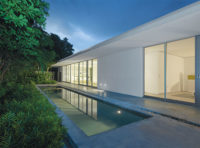VH R-10 gHouse
Pushing the envelope: Darren Petrucci reinvents the vacation guesthouse with the VH R-10 gHouse on Martha's Vineyard.
Architects & Firms
Vineyard Haven, Massachusetts
Record Houses 2008
Glenburn House ![]() H16
H16 ![]() Maltman Bungalows
Maltman Bungalows ![]() Palmyra House
Palmyra House ![]() The Rolling Huts
The Rolling Huts ![]() Wall House
Wall House ![]() Dairy House
Dairy House ![]() Nora House
Nora House ![]() VH r-10 gHouse
VH r-10 gHouse
Restrictive zoning, rather than necessity, is often the mother of architectural invention. Made to withstand the harsh winters of Martha’s Vineyard while treading lightly on the island, the VH R-10 gHouse, designed by architect Darren Petrucci, AIA, was so profoundly shaped by local restrictions that it adopted the zoning district—R-10—as part of its name.
Even though Martha’s Vineyard was originally (and still is) home to the Wampanoag Indians, it put itself on the map in the 19th century during the rise of the whaling industry. Today, the island is best known for its pristine beaches and quaint New England villages, and has firmly established itself as a summer colony and magnet for the rich and famous. Petrucci and his wife, Renata Hejduk, an assistant professor of architectural history and theory at Arizona State University, in Tempe (and daughter of the late John Hejduk), were drawn to the Vineyard for the same reasons that have attracted other vacationers. The couple, who spend most of their time in the Phoenix area, were not interested in a beach house or isolated retreat, however. Petrucci, the director of Arizona State University’s School of Architecture + Landscape Architecture, where he also runs a research and design lab that focuses on urban amenities and infrastructures, hoped to build a high-performance prototype house incorporating contemporary building techniques within walking distance of one of the island’s towns. When he and his wife learned of a lot for sale on the outskirts of Vineyard Haven, a community of traditional 19th- to mid-20th-century wood-shingled buildings, they jumped on the rare find.
The gently sloping corner property was appealing on a number of counts. At 12,518 square feet, it just met the zoning requirement to legally accommodate both a main house and a guesthouse. With economy and the future value of the lot in mind, the couple opted to build a guesthouse first, reserving the right to build a larger main house later. However, local zoning restrictions are rigid: Guesthouses in the district, for example, may encompass no more than 600 square feet, their height may not exceed 24 feet, and a particularly ornery clause stipulates that the basement may not be accessed from the building’s interior.
To maximize the allowable envelope, Petrucci drew a 16-by-40-by-24-foot box based on a 4-foot construction module. Structurally insulated panels (SIPs) enclose three staggered, rectilinear volumes for cooking, living, and sleeping. Though the center volume is shifted out 4 feet to accommodate an exterior stair, a mahogany rain screen unifies the volumes, enveloping the stair and blurring the line between outside and in. The program called for a kitchen, living area, and master bedroom on the main level. The small loft and spacious lower-level guest suite do not count toward the square footage allotted by zoning so, cleverly, 600 technical square feet become 1,000 square feet of livable space. A raised deck, accessed by the exterior stair, creates a secluded aerie in the tree canopy.



